Spatiotemporal Dynamics and Spatial Determinants of Urban Growth in Suzhou, China
Abstract
:1. Introduction
2. Data and Methods
2.1. Study Area and Data
2.1.1. Study Area
2.1.2. Data
2.2. Methods
2.2.1. Land Use Data Sampling
2.2.2. Selection of Landscape Metrics
2.2.3. Type of Urban Growth
2.2.4. Sector and Concentric Circle Analyses
2.2.5. Logistic Regression Model
2.2.6. Specification of Dependent and Independent Variables
2.2.7. Geographically Weighted Logistic Regression
3. Spatiotemporal Dynamics of Urban Growth
3.1. Changes in Landscape Characteristics
3.2. Typology of Urban Growth
3.3. Changing Urban Growth Patterns
3.4. Economic Transition and Urban Growth
3.4.1. From Bottom-Up Rural Urbanization to Top-Down Urban Expansion
3.4.2. From TVE-Driven Urbanization to FDI-Driven Development Zone Fever
4. Spatial Determinants of Urban Growth
4.1. Global Logistic Regression Model
4.2. Spatial Variations of Urban Growth Patterns
5. Conclusions
Acknowledgments
Author Contributions
Conflicts of Interest
References
- Yeh, A.G.O.; Li, X. Economic development and agricultural land loss in the Pearl River Delta, China. Habitat Int. 1999, 23, 373–390. [Google Scholar]
- Seto, K.C.; Woodcock, C.E.; Song, C.; Huang, X.; Lu, J.; Kaufmann, P.K. Monitoring land-use change in the Pearl River Delta using Landsat TM. Int. J. Remote Sens. 2002, 23, 1985–2004. [Google Scholar] [CrossRef]
- Long, H.L.; Tang, G.P.; Li, X.B.; Heilig, G.K. Socio-economic driving forces of land use change in Kunshan, the Yangtze River Delta economic area of China. J. Environ. Manag. 2007, 83, 351–364. [Google Scholar] [CrossRef] [PubMed]
- Page, J.; Davis, B.; Areddy, J. China turns predominantly urban. The Wall Street Journal, 18 January 2012; A10. [Google Scholar]
- Xie, Y.C.; Yu, M.; Bai, Y.F.; Xing, X.R. Ecological analysis of an emerging urban landscape pattern—Desakota: A case study in Suzhou, China. Landsc. Ecol. 2006, 21, 1297–1309. [Google Scholar] [CrossRef]
- Wei, Y.H.D. Regional development in China: Transitional institutions, embedded globalization, and hybrid economies. Eurasian Geogr. Econ. 2007, 48, 16–36. [Google Scholar] [CrossRef]
- Cheng, J.Q.; Masser, I. Urban growth pattern modeling: A case study of Wuhan city, PR China. Landsc. Urban Plan. 2003, 62, 199–217. [Google Scholar] [CrossRef]
- Luo, J.; Wei, Y.H.D. Modeling spatial variations of urban growth patterns in Chinese cities: The case of Nanjing. Landsc. Urban Plan. 2009, 91, 51–64. [Google Scholar] [CrossRef]
- Liao, F.H.F.; Wei, Y.H.D. Modeling determinants of urban growth in Dongguan, China: A spatial logistic approach. Stoch. Environ. Res. Risk Assess. 2014, 28, 801–816. [Google Scholar] [CrossRef]
- Lin, G.C.S.; Wei, Y.H.D. China’s restless urban landscape 1: New challenge for theoretical reconstruction. Environ. Plan. A 2002, 34, 1535–1544. [Google Scholar] [CrossRef]
- Deng, F.F.; Huang, Y.Q. Uneven land reform and urban sprawl in China: The case of Beijing. Prog. Plan. 2003, 61, 211–236. [Google Scholar] [CrossRef]
- Lin, G.C.S.; Ho, S.P.S. The state, land system, and land development processes in contemporary China. Ann. Assoc. Am. Geogr. 2005, 95, 411–436. [Google Scholar] [CrossRef]
- Wei, Y.H.D. Restructuring for growth in urban China: Transitional institutions, urban development, and spatial transformation. Habitat Int. 2012, 36, 396–405. [Google Scholar] [CrossRef]
- Wei, Y.H.D. Zone fever, project fever: Development policy, economic transition, and urban expansion in China. Geogr. Rev. 2015, 105, 156–177. [Google Scholar] [CrossRef]
- Xie, Y.C.; Batty, M.; Zhao, K. Simulating emergent urban form using agent-based modeling: Desakota in the. Suzhou-Wuxian region in China. Ann. Assoc. Am. Geogr. 2007, 97, 477–495. [Google Scholar] [CrossRef]
- Li, X.; Yeh, A.G.O. Modelling sustainable urban development by the integration of constrained cellular automata and GIS. Int. J. Geogr. Inf. Sci. 2000, 14, 131–152. [Google Scholar] [CrossRef]
- Li, X.; Yeh, A.G.O. Neural-network-based cellular automata for simulating multiple land use changes using GIS. Int. J. Geogr. Inf. Sci. 2002, 16, 323–343. [Google Scholar] [CrossRef]
- McDonald, R.I.; Urban, D.L. Spatially varying rules of landscape change: Lessons from a case study. Landsc. Urban Plan. 2006, 74, 7–20. [Google Scholar] [CrossRef]
- Luo, J.; Yu, D.L.; Xin, M. Modeling urban growth using GIS and remote sensing. GISci. Remote Sens. 2008, 45, 426–442. [Google Scholar] [CrossRef]
- Wei, Y.H.D.; Lu, Y.Q.; Chen, W. Globalizing regional development in Sunan, China: Does Suzhou Industrial Park fit a Neo-Marshallian District model? Reg. Stud. 2009, 43, 409–427. [Google Scholar]
- Wei, Y.H.D. Beyond the Sunan model: Trajectory and underlying factors of development in Kunshan, China. Environ. Plan. A 2002, 34, 1725–1747. [Google Scholar]
- Breiman, L. Random forests. Mach. Learn. 2001, 45, 5–32. [Google Scholar] [CrossRef]
- Liaw, A.; Wiener, M. Classification and regression by random forest. R News 2002, 2, 18–22. [Google Scholar]
- Liu, Y.; Yue, W.Z.; Fan, P.L. Spatial determinants of urban land conversion in large Chinese cities: A case of Hangzhou. Environ. Plan. B 2011, 38, 706–725. [Google Scholar] [CrossRef]
- Herold, M.; Scepan, J.; Clarke, K.C. The use of remote sensing and landscape metrics to describe structures and changes in urban land uses. Environ. Plan. A 2002, 34, 1443–1458. [Google Scholar] [CrossRef]
- Seto, K.C.; Fragkias, M. Quantifying spatiotemporal patterns of urban land-use change in four cities of China with time series landscape metrics. Landsc. Ecol. 2005, 20, 871–888. [Google Scholar] [CrossRef]
- McGarigal, K.; Cushman, S.A.; Neel, M.; Ene, E. FRAGSTATS Version 4: Spatial Pattern Analysis Program for Categorical Maps; University of Massachusetts: Amherst, MA, USA, 2002; Available online: http://www.umass.edu/landeco/research/fragstats/fragstats.html (accessed on 6 March 2017).
- Yue, W.Z.; Liu, Y.; Fan, P.L. Polycentric urban development: The case of Hangzhou. Environ. Plan. A 2010, 42, 563–577. [Google Scholar] [CrossRef]
- Luck, M.; Wu, J. A gradient analysis of urban landscape pattern: A case study from the Phoenix metropolitan region, Arizona, USA. Landsc. Ecol. 2002, 17, 327–339. [Google Scholar] [CrossRef]
- Xu, C.; Liu, M.; Zhang, C.; An, S.Q.; Yu, W.; Chen, J.M. The spatiotemporal dynamics of rapid urban growth in the Nanjing metropolitan region of China. Landsc. Ecol. 2007, 22, 925–937. [Google Scholar] [CrossRef]
- Xu, J.G.; Liao, B.G.; Shen, Q.; Zhang, F.; Mei, A.X. Urban spatial restructuring in transitional economy—Changing land use pattern in Shanghai. Chin. Geogr. Sci. 2007, 17, 19–27. [Google Scholar] [CrossRef]
- Wu, F.L.; Yeh, A.G.O. Changing spatial distribution and determinants of land development in Chinese cities in the transition from a centrally planned economy to a socialist market economy: A case study of Guangzhou. Urban Stud. 1997, 34, 1851–1879. [Google Scholar] [CrossRef]
- Verburg, P.H.; van Eck, J.R.R.; de Nijs, T.C.M.; Dijst, M.J.; Schot, P. Determinants of land-use change patterns in the Netherlands. Environ. Plan. B 2004, 31, 125–150. [Google Scholar] [CrossRef]
- Seto, K.C.; Kaufmann, R.K. Modeling the drivers of urban land use change in the Pearl River Delta, China: Integrating remote sensing with socioeconomic data. Land Econ. 2003, 79, 106–121. [Google Scholar] [CrossRef]
- Fotheringham, A.S.; Brunsdon, C.; Charlton, M.E. Geographically Weighted Regression: The Analysis of Spatially Varying Relationships; John Wiley & Sons Ltd.: Chichester, UK, 2002. [Google Scholar]
- Fotheringham, A.S.; Charlton, M.E.; Brunsdon, C. Spatial variations in school performance: A local analysis using geographically weighted regression. Geogr. Environ. Model. 2001, 5, 43–66. [Google Scholar] [CrossRef]
- Gilbert, A.; Chakraborty, J. Using geographically weighted regression for environmental justice analysis: Cumulative cancer risks from air toxics in Florida. Soc. Sci. Res. 2011, 40, 273–286. [Google Scholar] [CrossRef]
- Nakaya, T. GWR4 User Manual. GWR 4 Development Team, 2014. Available online: https://geodacenter.asu.edu/drupal_files/gwr/GWR4manual.pdf (accessed on 12 December 2015).
- Chen, X.Y. Land restoration resulted in 55 thousand mu of new agricultural land during the past 8 years in Suzhou. Suzhou Daily, 2014; 30, A1. [Google Scholar]
- Ho, S.P.S.; Lin, G.C.S. Non-Agricultural land use in post-reform China. China Q. 2004, 179, 758–781. [Google Scholar] [CrossRef]
- Cui, G.H.; Ma, L.J.C. Urbanization from below in China: Its development and mechanism. Acta Geogr. Sin. 1999, 54, 106–115. (In Chinese) [Google Scholar]
- Ma, L.J.C.; Fan, M. Urbanization from below: The growth of towns in Jiangsu, China. Urban Stud. 1994, 31, 1625–1645. [Google Scholar] [CrossRef]
- Cartier, C. ‘Zone fever’, the arable land debate, and real estate speculation: China’s evolving land use regime and its geographical contradictions. J. Contemp. China 2000, 10, 445–469. [Google Scholar] [CrossRef]
- Yang, D.Y.R.; Wang, H.K. Dilemmas of local governance under the development zone fever in China. Urban Stud. 2008, 45, 1037–1054. [Google Scholar] [CrossRef]
- Gao, J.; Wei, Y.D.; Chen, W.; Yenneti, K. Urban land expansion and structural change in the Yangtze River Delta, China. Sustainability 2015, 7, 10281–10307. [Google Scholar] [CrossRef]
- Qin, B.Q.; Xu, P.Z.; Wu, Q.L.; Luo, L.C.; Zhang, Y.L. Environmental issues of Lake Taihu, China. Hydrobiologia 2007, 581, 3–14. [Google Scholar] [CrossRef]
- Li, G.L.; Chen, J.; Sun, Z.Y. Non-agricultural land expansion and its driving forces: A multi-temporal study of Suzhou, China. Int. J. Sustain. Dev. World Ecol. 2007, 14, 408–420. [Google Scholar] [CrossRef]
- Dahal, K.R.; Benner, S.; Lindquist, E. Urban hypotheses and spatiotemporal characterization of urban growth in the Treasure Valley of Idaho, USA. Appl. Geogr. 2017, 79, 11–25. [Google Scholar] [CrossRef]
- Wei, Y.H.D. Towards equitable and sustainable urban space. Sustainability 2016, 8, 804. [Google Scholar] [CrossRef]
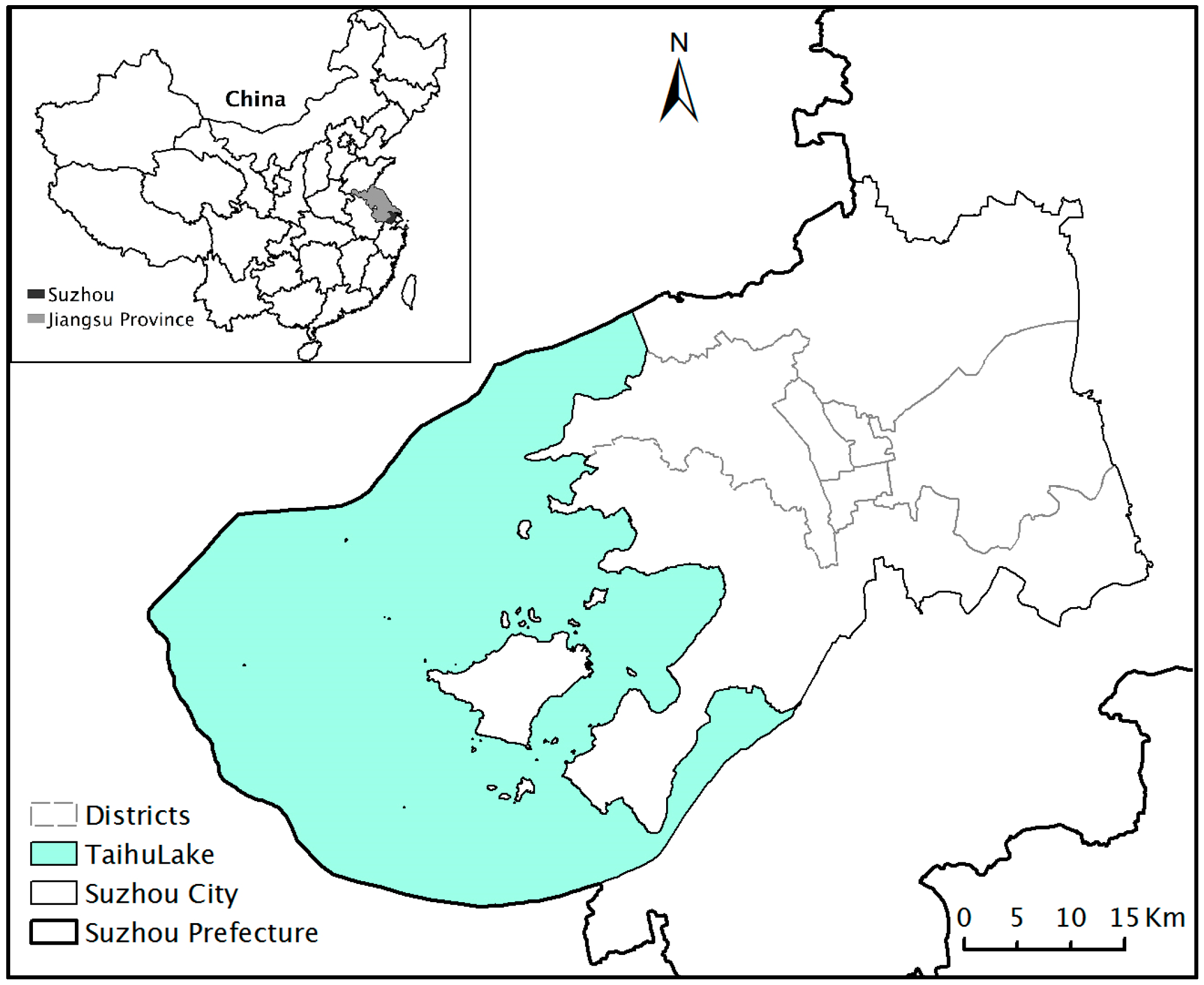
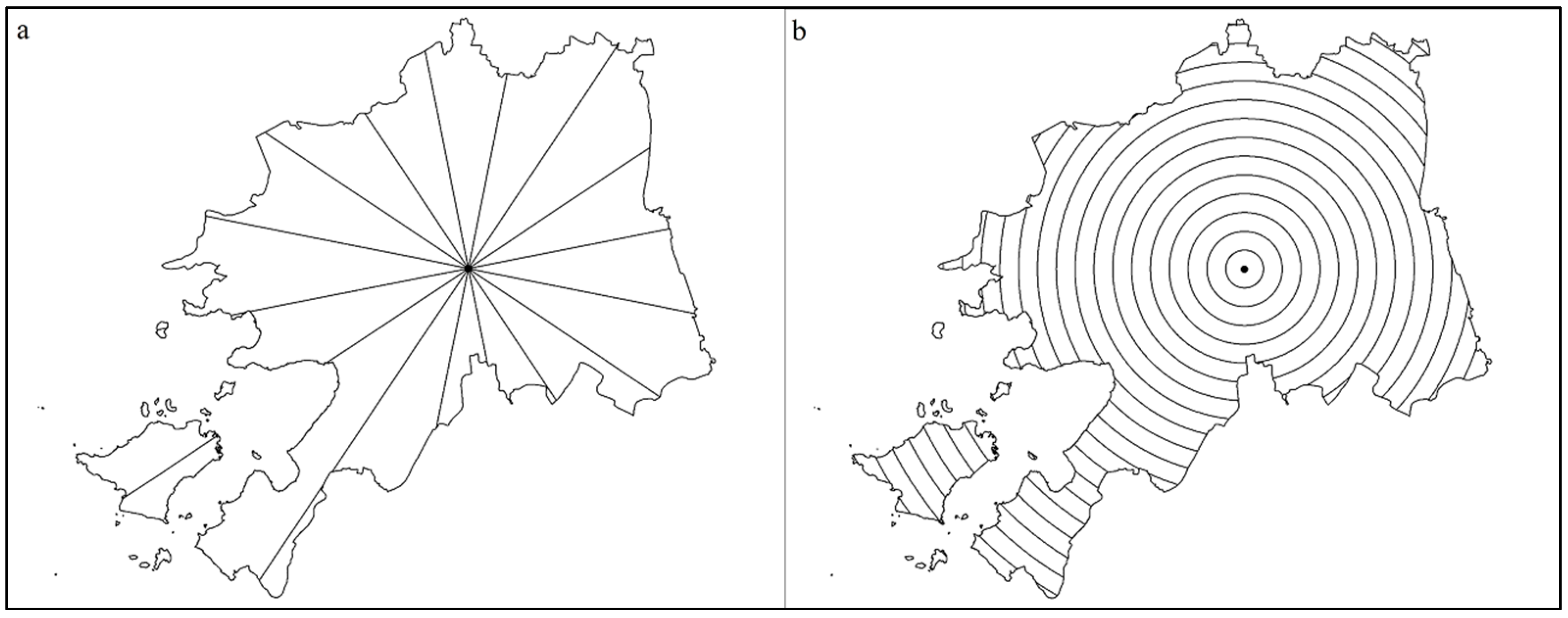
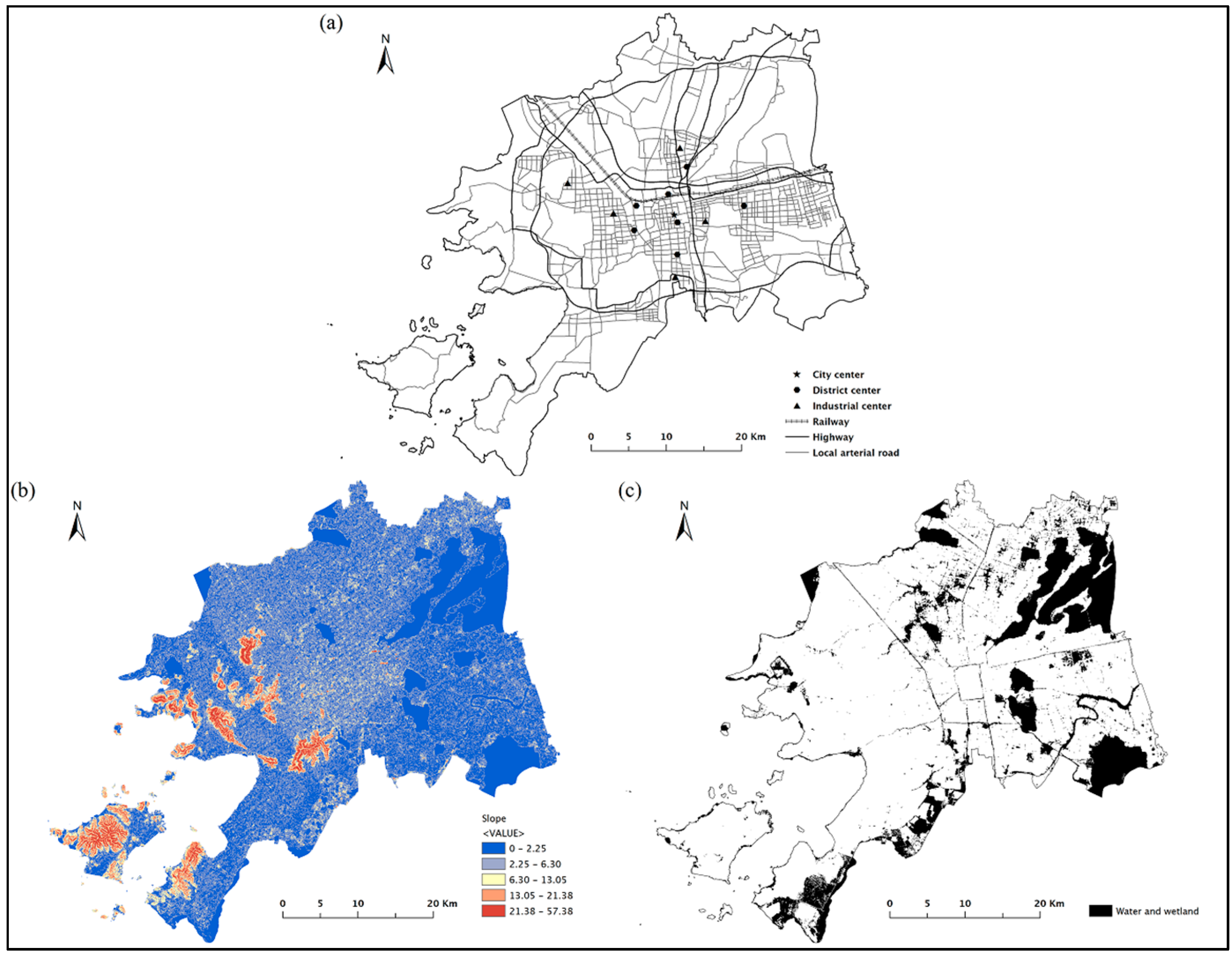
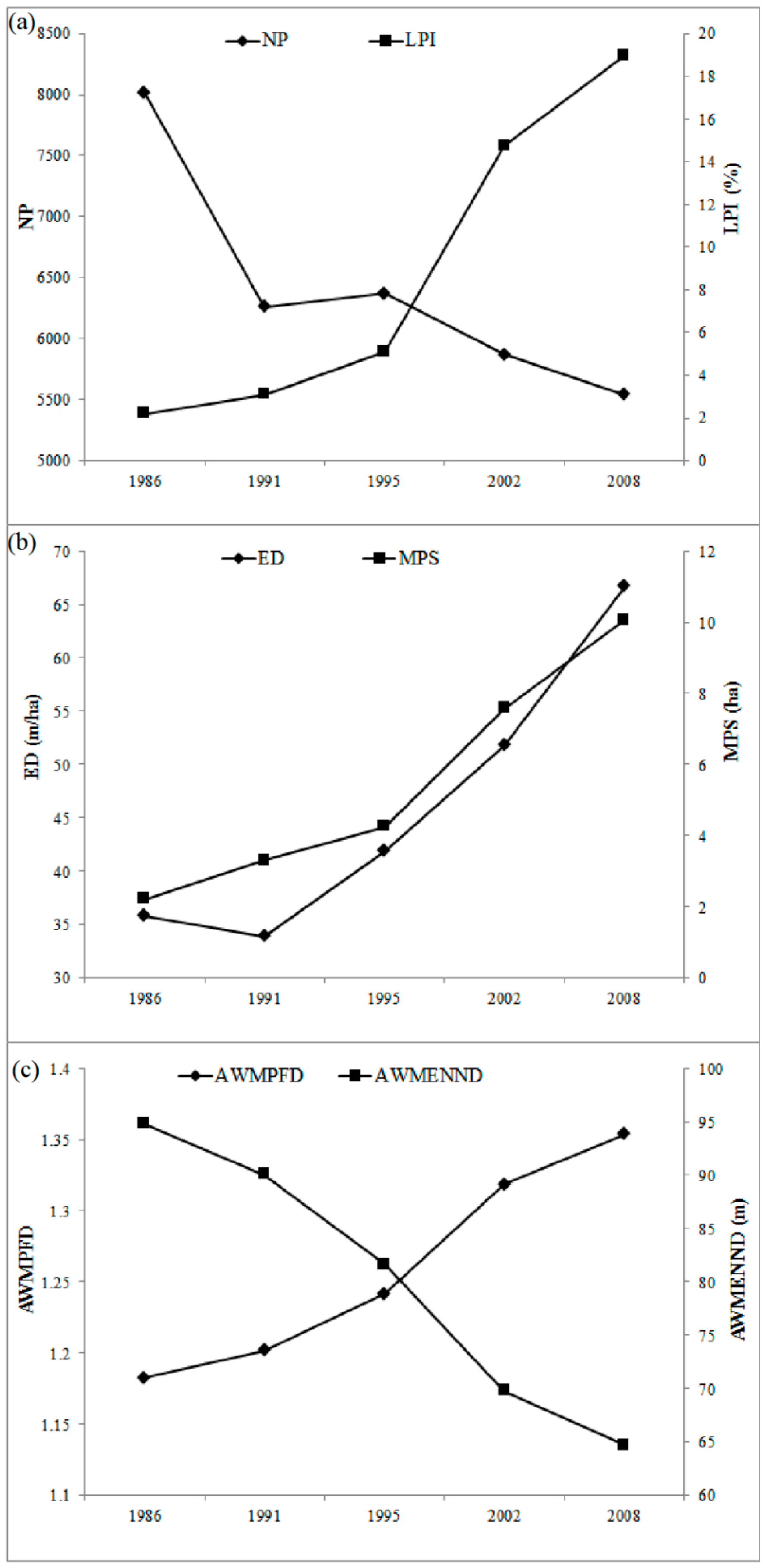

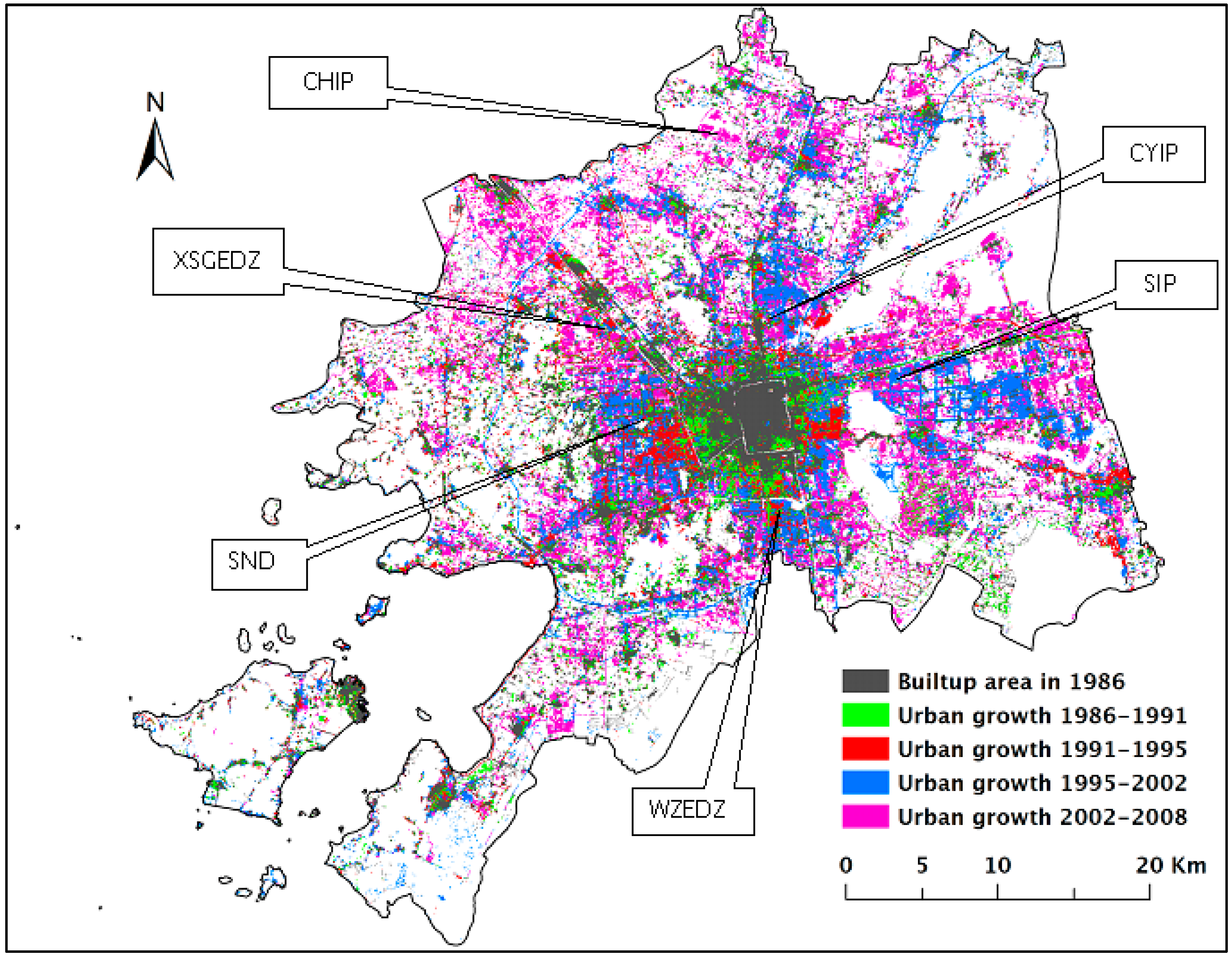
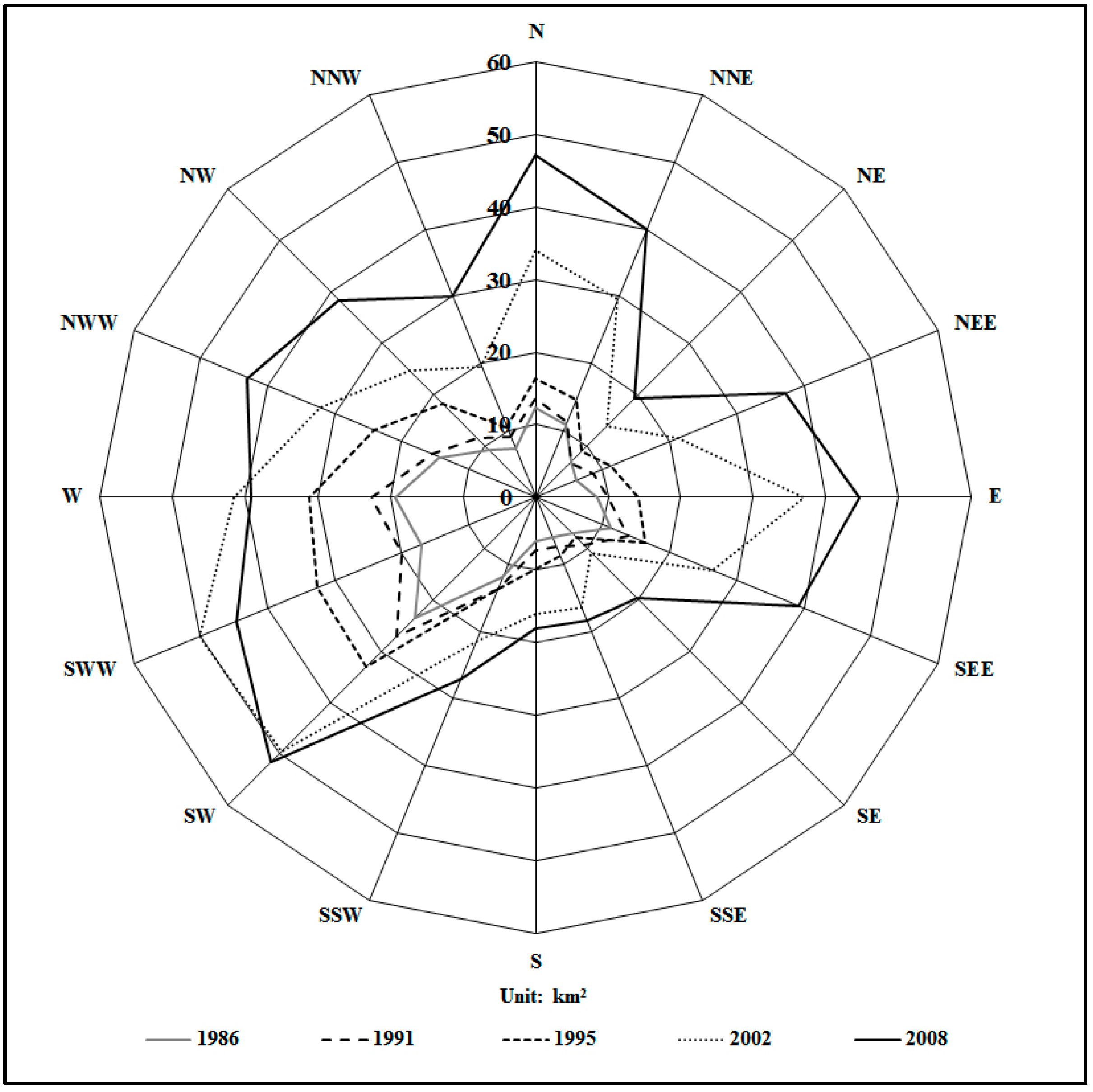
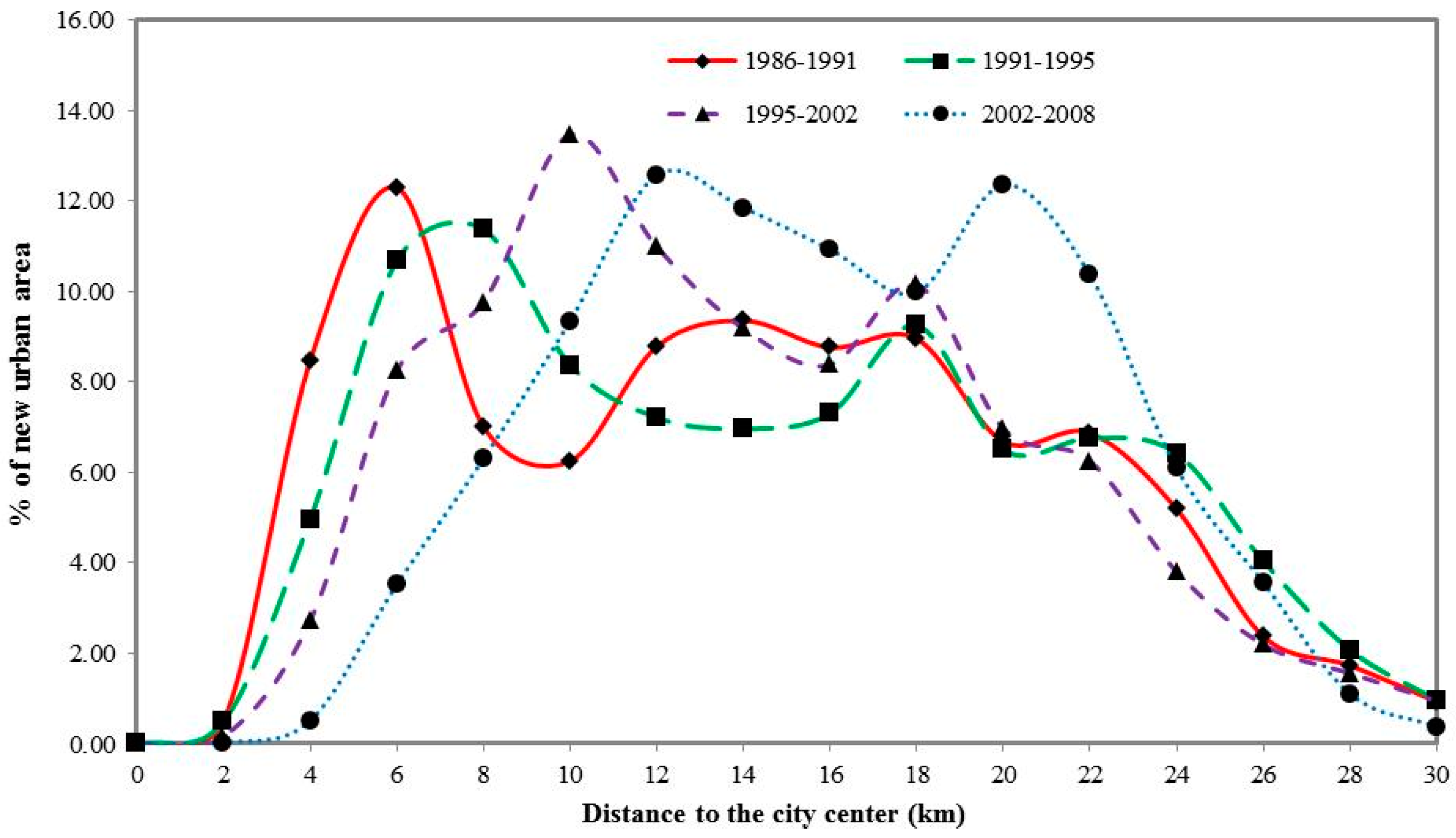

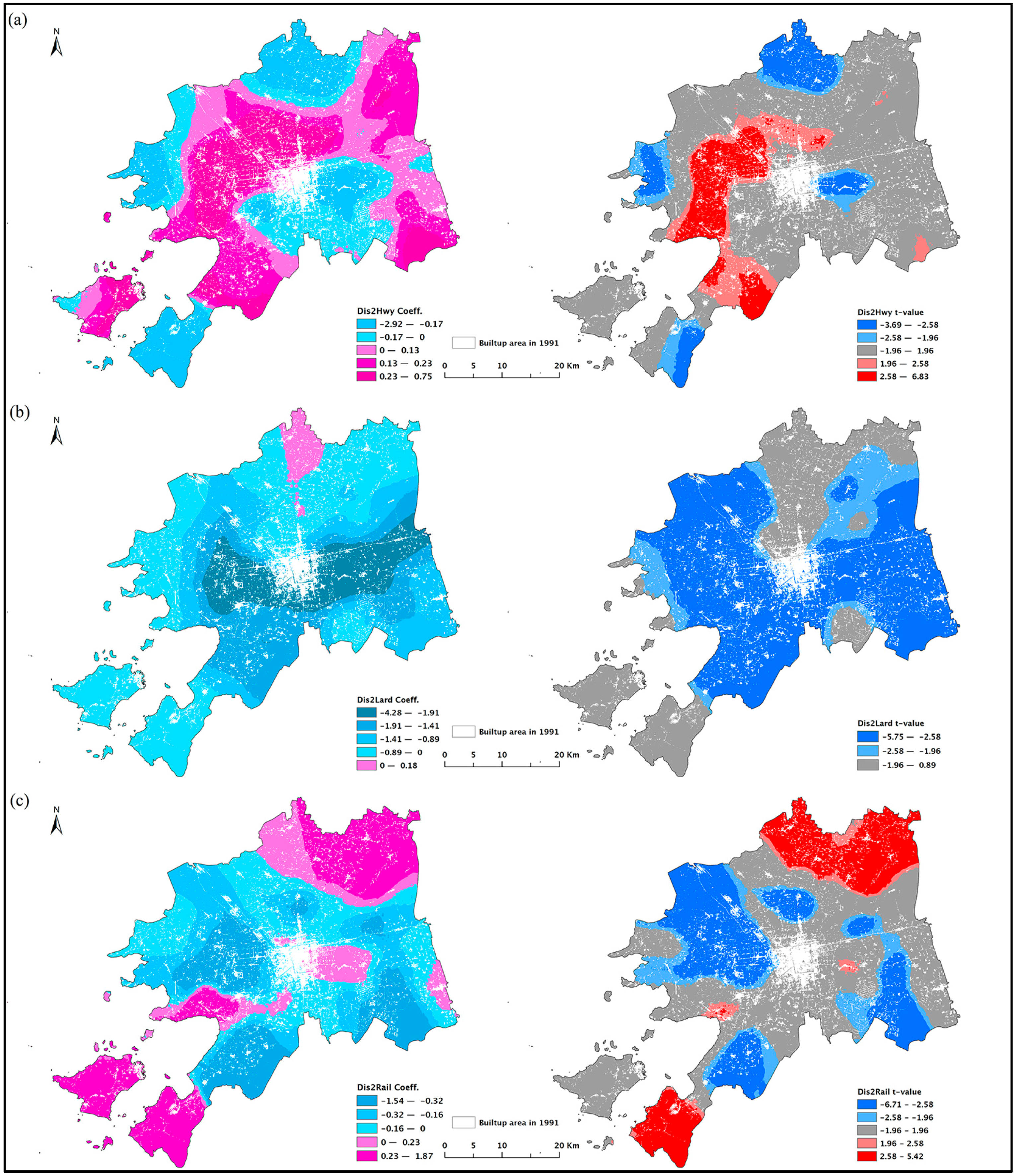
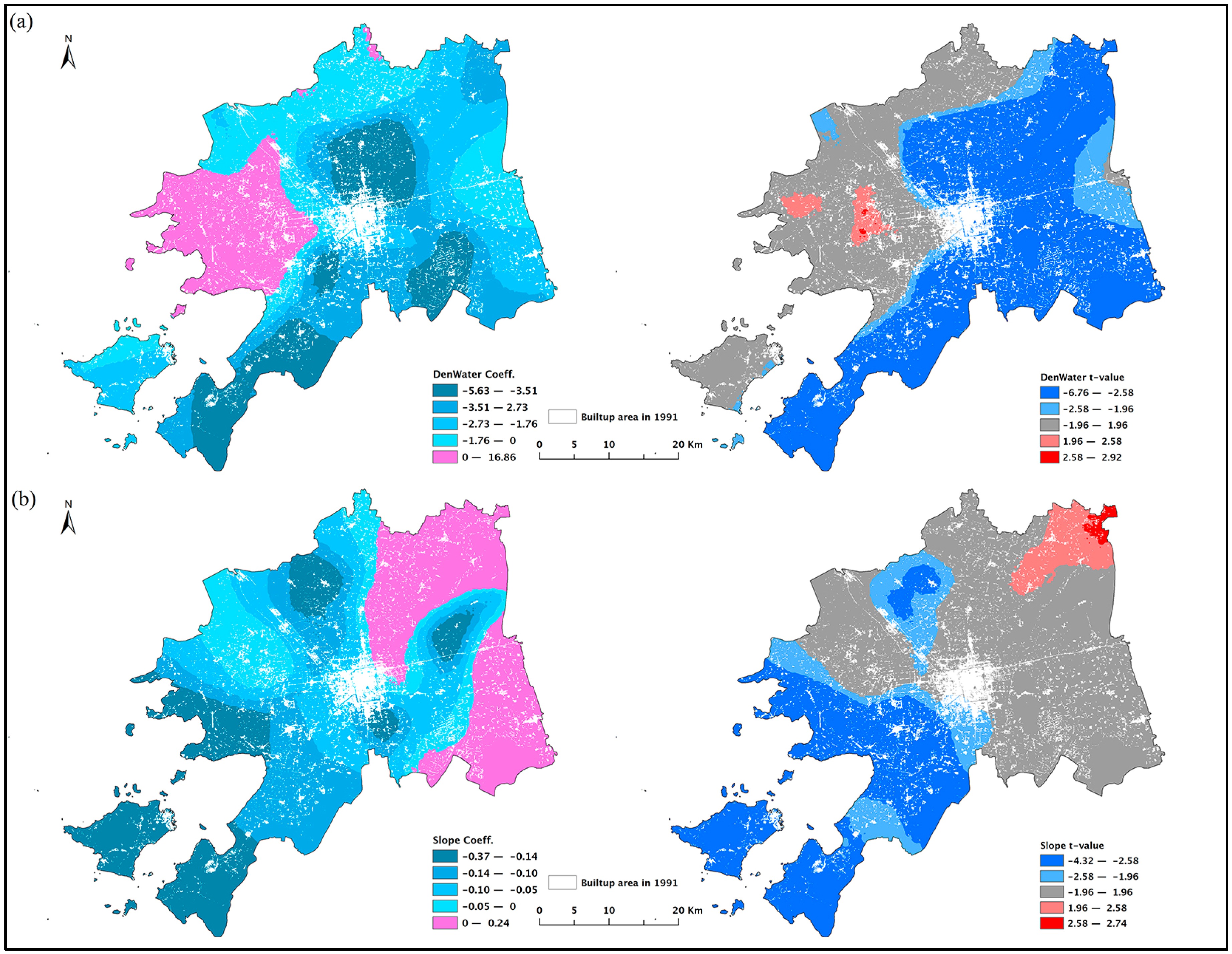
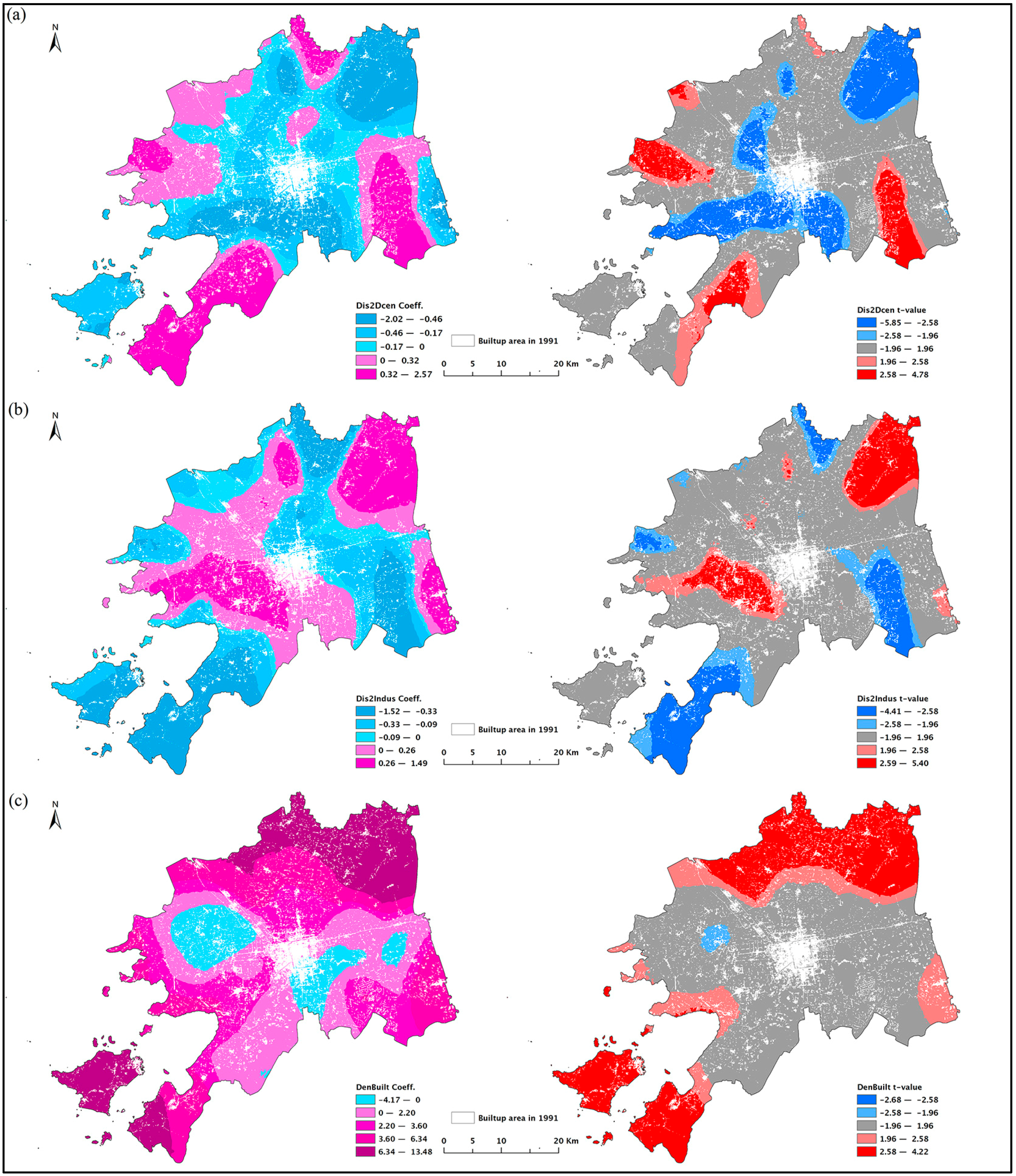
| Metrics | Unit | Range | Formula and Description |
|---|---|---|---|
| NP | None | NP ≥ 0 |  |
| NP equals the number of patches of the corresponding patch type (class) | |||
| LPI | Percent | 0 < LPI ≤ 100 |  |
| LPI equals the area (m2) of the largest patch of the corresponding patch type, divided by total landscape area (m2), multiplied by 100 (to convert to a percentage) | |||
| ED | Meters per hectare | ED ≥ 0 |  |
| ED equals the sum of the lengths (m) of all edge segments involving the corresponding patch type, divided by the total landscape area (m2), multiplied by 10,000 (to convert to hectares) | |||
| MPS | Hectares | MPS > 0 |  |
| MPS equals the sum of areas (m2) of all patches of the corresponding patch type, divided by the number of patches of the same type, divided by 10,000 (to convert to hectares) | |||
| AWMPFD | None | 1 < AWMPFD ≤ 2 |  |
| AWMPFD equals the sum, across all patches of the corresponding patch type, of two times the logarithm of 0.25 the times patch perimeter (m), divided by the logarithm of patch area (m2), multiplied by the patch area (m2) divided by total class area | |||
| AWMENND | Meters | AWMENND ≥ 0 |  |
| AWMENND equals the sum, across all patches of the corresponding patch type, of the nearest neighbor distance of each patch, multiplied by the proportional abundance of the patch (i.e. patch area divided by the sum of patch areas) |
| Variables | Descriptions |
|---|---|
| Dependent Variable | |
| Change | Land conversion from nonurban to urban |
| Independent variables | |
| Proximity to transportation infrastructure | |
| Dis2Hwy | Distance to intercity highways |
| Dis2Lard | Distance to local arterial roads |
| Dis2Rail | Distance to railways |
| Neighborhood physical condition | |
| DenWater | Density of waters (water and wetland) |
| Slope | Slope of sample points measured by degree |
| Socioeconomic factors | |
| Dis2Dcen | Distance to district center |
| Dis2Indu | Distance to industrial center |
| DenBuilt | Density of built-up area |
| Variable | Min. | Max | Mean | STD |
|---|---|---|---|---|
| Dis2Hwy | 0.060 | 29.068 | 4.356 | 5.094 |
| Dis2Lard | 0.030 | 7.611 | 0.716 | 0.922 |
| Dis2Rail | 0.030 | 44.172 | 11.238 | 8.992 |
| DenWater | 0.000 | 1.000 | 0.213 | 0.311 |
| Slope | 0.000 | 35.035 | 3.192 | 4.454 |
| Dis2Dcen | 0.095 | 41.670 | 11.957 | 8.100 |
| Dis2Indu | 0.170 | 40.853 | 10.854 | 7.631 |
| DenBuilt | 0.000 | 0.909 | 0.086 | 0.099 |
| Independent Variables | Coef. | Std. Err. | z Value | Pr (>|z|) |
|---|---|---|---|---|
| Dis2Hwy | 0.046 | 0.014 | 3.366 | 0.001 |
| Dis2Lard | −0.873 | 0.079 | −11.106 | 0.000 |
| Dis2Rail | −0.048 | 0.008 | −6.153 | 0.000 |
| DenWater | −2.362 | 0.166 | −14.215 | 0.000 |
| Slope | −0.106 | 0.012 | −8.762 | 0.000 |
| DisDcen | −0.098 | 0.011 | −8.997 | 0.000 |
| Dis2Indu | 0.021 | 0.011 | 1.911 | 0.056 |
| DenBuilt | 3.379 | 0.465 | 7.265 | 0.000 |
| Constant | 2.223 | 0.106 | 21.056 | 0.000 |
| Sample size | 4818 | |||
| -2 Log-Likelihood | 4645.499 | |||
| PCPa | 76.6 |
| Global Logistic Model | Logistic GWR | |
|---|---|---|
| -2 Log-Likelihood | 4645.499 | 3942.417 |
| PCP | 76.6 | 80.2 |
| Pseudo R2 | 0.3045 | 0.4097 |
| Residual sum of squares | 763.9226 | 643.9371 |
| Moran’s I of residuals | 0.0731 | 0.0197 |
| ROC | 0.847 | 0.890 |
| AICc | 4663.5371 | 4196.4052 |
| Variable | Min. | Max. | Mean | STD | % Positive | % Negative |
|---|---|---|---|---|---|---|
| Dis2Hwy | −2.922 | 0.748 | −0.008 | 0.433 | 60.46 | 39.54 |
| Dis2Lard | −4.286 | 0.177 | −1.275 | 0.882 | 3.94 | 96.06 |
| Dis2Rail | −1.544 | 1.867 | −0.044 | 0.476 | 33.96 | 66.04 |
| DenWater | −5.627 | 16.877 | −1.803 | 2.236 | 16.19 | 83.81 |
| Slope | −0.369 | 0.241 | −0.065 | 0.129 | 25.61 | 74.39 |
| DisDcen | −2.020 | 2.573 | −0.034 | 0.648 | 41.24 | 58.76 |
| Dis2Indu | −1.515 | 1.491 | −0.015 | 0.468 | 46.82 | 53.18 |
| DenBuilt | −4.175 | 13.484 | 3.376 | 3.420 | 85.84 | 14.16 |
© 2017 by the authors. Licensee MDPI, Basel, Switzerland. This article is an open access article distributed under the terms and conditions of the Creative Commons Attribution (CC BY) license ( http://creativecommons.org/licenses/by/4.0/).
Share and Cite
Zhang, L.; Wei, Y.D.; Meng, R. Spatiotemporal Dynamics and Spatial Determinants of Urban Growth in Suzhou, China. Sustainability 2017, 9, 393. https://doi.org/10.3390/su9030393
Zhang L, Wei YD, Meng R. Spatiotemporal Dynamics and Spatial Determinants of Urban Growth in Suzhou, China. Sustainability. 2017; 9(3):393. https://doi.org/10.3390/su9030393
Chicago/Turabian StyleZhang, Ling, Yehua Dennis Wei, and Ran Meng. 2017. "Spatiotemporal Dynamics and Spatial Determinants of Urban Growth in Suzhou, China" Sustainability 9, no. 3: 393. https://doi.org/10.3390/su9030393
APA StyleZhang, L., Wei, Y. D., & Meng, R. (2017). Spatiotemporal Dynamics and Spatial Determinants of Urban Growth in Suzhou, China. Sustainability, 9(3), 393. https://doi.org/10.3390/su9030393






